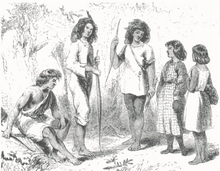Chetco people

The Chetco (Chetco: chit-dee-ni, chit-dee-ne [1]) are a tribe of Native Americans who originally lived along the lower Chetco River in Curry County in the U.S. state of Oregon. The name Chetco comes from the word meaning "close to the mouth of the stream" in their own language, which is part of the Athapascan languages.[2] Although they were once one of the largest tribes on the Pacific coast of Oregon, "the last known full-blooded Chetco" died in 1940, and as of 2009 only 1500 or so descendants of the tribe remain.[3] Some Chetco people are enrolled in federally recognized tribes, the Confederated Tribes of Siletz Indians in Oregon, and Cher-Ae Heights Indian Community of the Trinidad Rancheria, located in Humboldt County, California.[4]
Language and name
The Chetco language is a member of the Athapascan languages, which also includes most native languages in Alaska, the Apache and Navajo languages in the southwest United States, and the languages spoken by the Rogue River and Tolowa tribes in Oregon. The name Chetco comes from the word Cheti in their own language, meaning "close to the mouth of the stream".[2] The nine villages of the tribe on the Chetco River were named Chettanne, Chettannene (twin villages at the mouth of the river), Khuniliikhwut, Nakwutthume, Nukhwuchutun, Setthatun, Siskhaslitun, Tachukhaslitun, and Thlcharghilitun.[2]
History

The Chetco are believed to have come to coastal Oregon between 3000 and 1000 years ago.[5] They had nine villages on the lower 14 miles (23 km) of the Chetco River, with their principal villages at the mouth, where the river flows into the Pacific Ocean.[2] The Chetco territory extended a short distance on either side of the river, along the Pacific coast from Pistol River in the north to the Winchuck River in the south.[3] They were the most populous of the 12 coastal tribes in southern Oregon.[5]
The Chetco were hunter-gatherers with a diet based on hunting deer and elk, gathering acorns and mussels, and fishing. They used dugout canoes on the ocean and river and worked with stone tools. The Chetco cooked on open fires or with simple pots, and were culturally very similar to the Tolowa tribe to the south, "who shared the same customs regulating social relationships and frequently intermarried".[6]
The tribe is thought to have had perhaps one thousand members at its peak,[3] but its numbers declined after European-American settlers came into contact with the Chetco in the 19th century.[6] Settlers destroyed the Chetco villages in 1853 and the surviving members of the tribe were forcibly removed to the Siletz Reservation in Tillamook County, Oregon (in 1879 the land the reservation is on became part of Lincoln County). In 1854 there were 241 members of the tribe on the reservation: 83 women, 117 men, and 41 children. By 1861 there were 262 on the reservation: 96 women, 62 men, and 104 children; by 1871 the total on the reservation had dropped to 63.[2] Lucy Dick, who died in 1940 was "the last known full-blooded Chetco"; as of 2009.[3]
Notes
- ^ "Siletz Talking Dictionary". Retrieved 2012-06-04.
- ^ a b c d e Hodge, Frederick Webb, ed. (September 1912). Handbook of American Indians North of Mexico, Part 1 (Fourth ed.). Washington, D.C.: Smithsonian Institution, Bureau of American Ethnology, Government Printing Office. pp. 108–111, 249. Retrieved June 27, 2010.
- ^ a b c d Schlchting, Bill (December 2, 2009). "Discovering Chetco culture". Curry Coastal Pilot. Retrieved June 27, 2010.
- ^ "Cher-Ae Heights Indian Community of the Trinidad Rancheria." Alliance for California Traditional Arts. 2009. Retrieved 25 June 2012.
- ^ a b "First residents were the Chetco". Curry Coastal Pilot. February 23, 2001. Retrieved June 27, 2010.
- ^ a b "Brookings, Oregon" (PDF). National Oceanic and Atmospheric Administration. Retrieved June 27, 2010.
